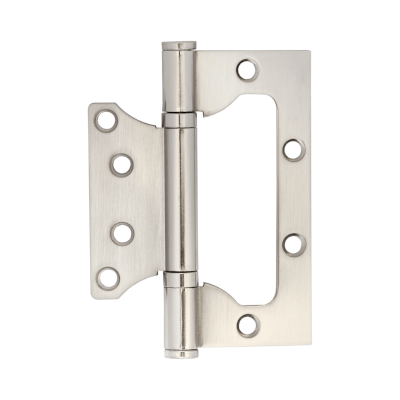What Is a Flag Hinge?
 A flag hinge is a metal fitting utilized for opening and closing various types of doors, such as interior doors, lightweight doors, gates, and lids. Named for its flag-like appearance when open, these removable hinges are known for their ease of installation and removal. Materials for flag hinges include iron, stainless steel, brass, resin, aluminum, and zinc alloy. Selection of the appropriate hinge is based on the size, weight of the door, and usage method. Some hinges feature a resin bushing in the knuckle to minimize wear-induced metal powder generation.
A flag hinge is a metal fitting utilized for opening and closing various types of doors, such as interior doors, lightweight doors, gates, and lids. Named for its flag-like appearance when open, these removable hinges are known for their ease of installation and removal. Materials for flag hinges include iron, stainless steel, brass, resin, aluminum, and zinc alloy. Selection of the appropriate hinge is based on the size, weight of the door, and usage method. Some hinges feature a resin bushing in the knuckle to minimize wear-induced metal powder generation.
Uses of Flag Hinges
Flag hinges are versatile and can be used for a range of applications, from connecting doors on boxes, shelves, and lightweight doors to heavier doors, ensuring smooth operation. They are commonly employed in entrance doors, door frames, control panels, machine tools, ships, vehicles, kitchen equipment, outdoor gear, cubicles, port facilities, and even in large-scale facilities like petroleum complexes and nuclear power plants.
Principle of Flag Hinges
Flag hinges feature a straightforward design, with two metal flags connected to a central bar. Each flag is mounted to the door and frame using screws or bolts. The flags are split into upper and lower sections on both the door and mounting sides, allowing for easy installation. A distinctive feature of flag hinges is their ability to rotate 360 degrees. Material choices, such as stainless steel or zinc alloy, depend on the application, with stainless steel being ideal for heavy-duty, corrosion-resistant applications like outdoor equipment or ships. Galvanized steel hinges are suited for large, heavy doors. For aluminum or steel-framed doors, surface-mounted zinc alloy types are optimal. Additionally, some flag hinges include plastic bushings to reduce wear, and they can be left or right-handed based on the door’s orientation.